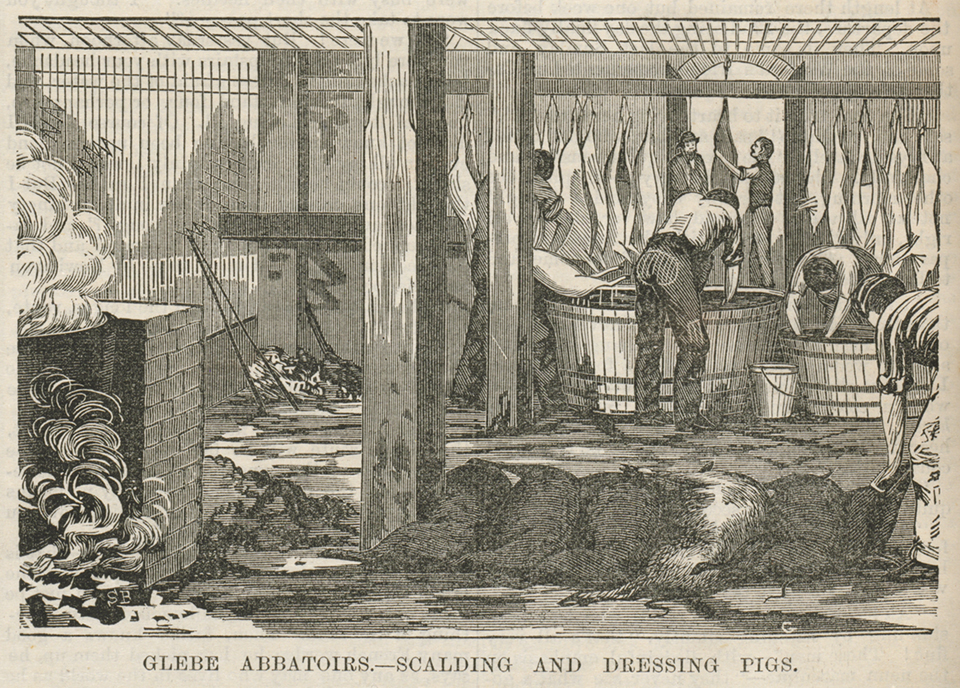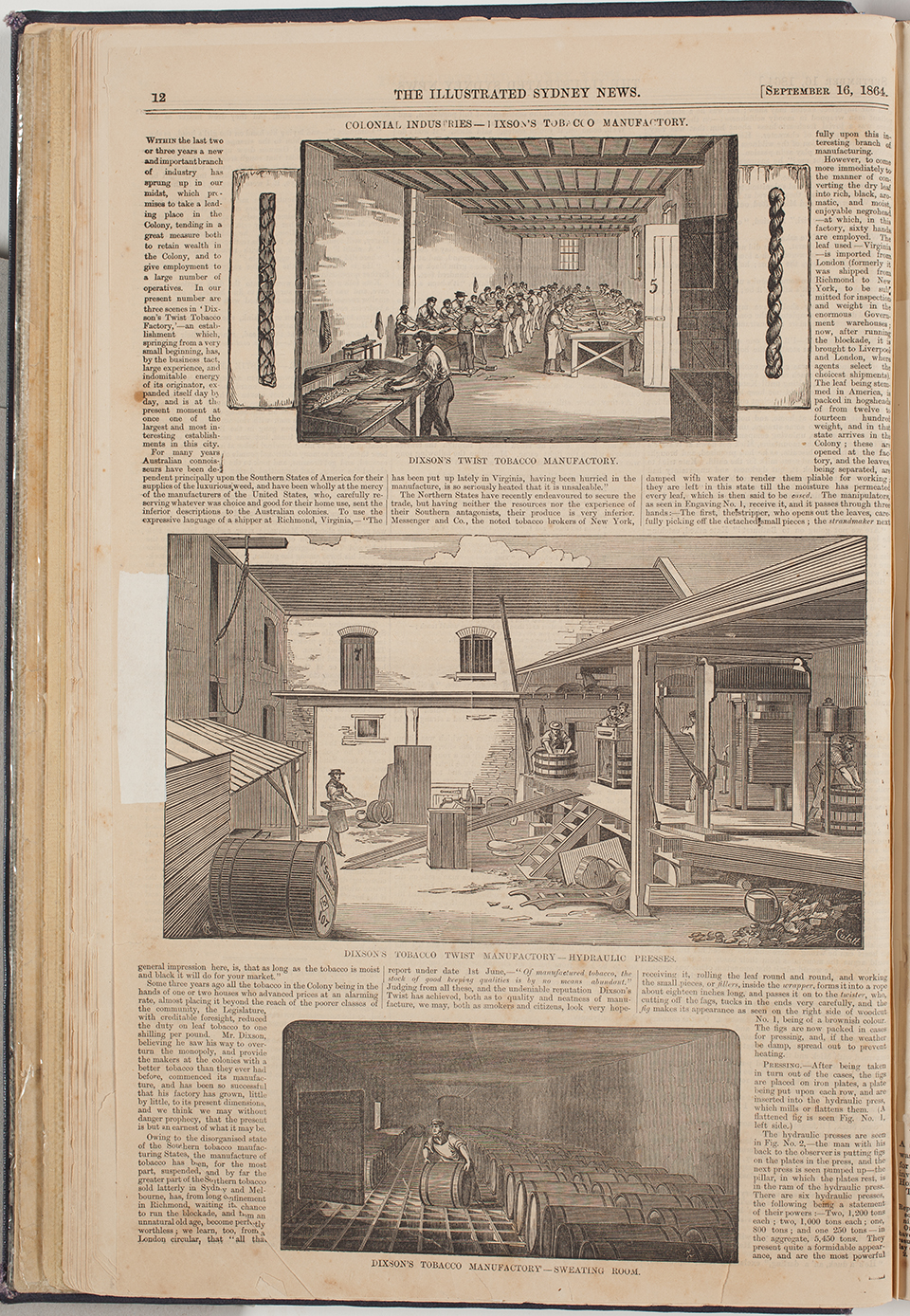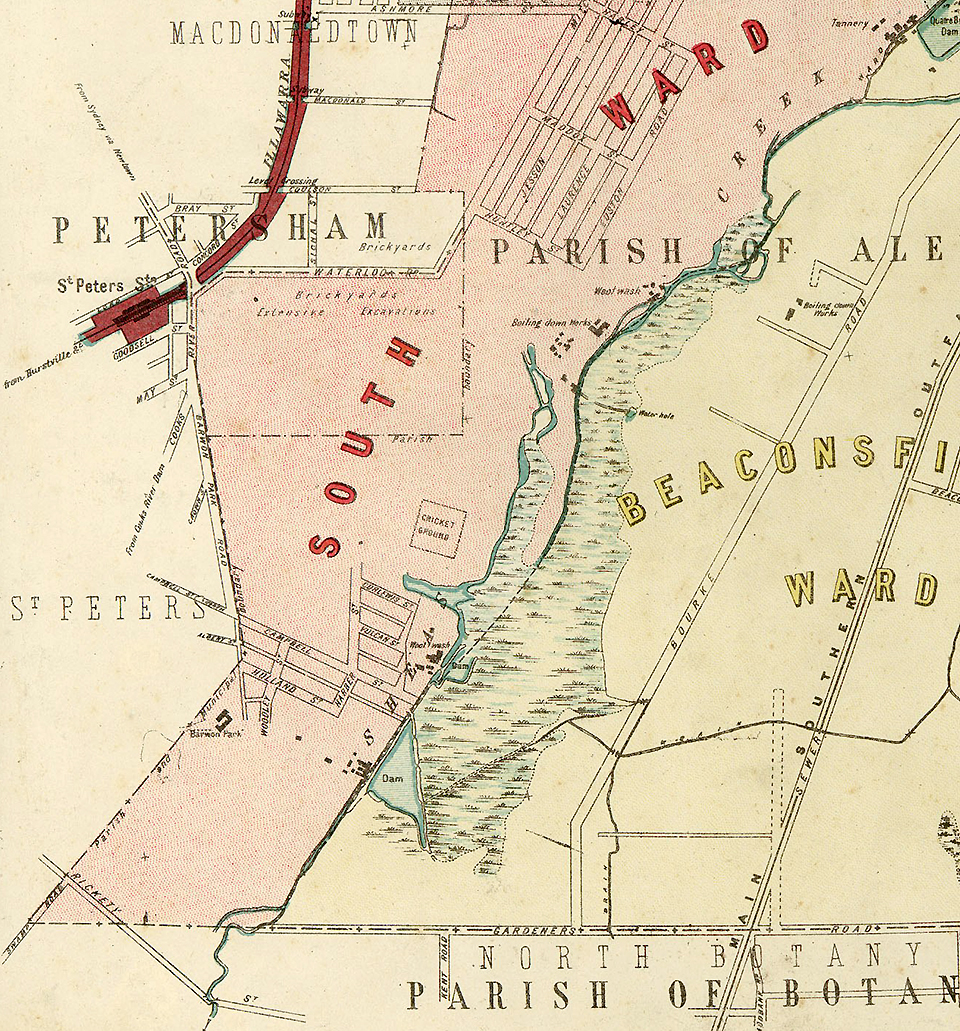The Dictionary of Sydney was archived in 2021.
Royal Commission into Noxious and Offensive Trades 1882
Citation
Persistent URL for this entry
To cite this entry in text
To cite this entry in a Wikipedia footnote citation
To cite this entry as a Wikipedia External link
Royal Commission on Noxious and Offensive Trades 1882
In the [media]nineteenth century, the term 'noxious trade' applied to any industry that created a stink, especially if this was associated with offensive waste. Primarily it covered industries associated with the processing of animal carcasses and hides – places such as tanneries, abattoirs, piggeries, fellmongers and boiling-down works – although sometimes chemical works or tobacco factories were included.
Before the [media]widespread understanding of germ theory, it was widely accepted that disease was spread by offensive vapours or miasmas. 'Miasmatist' views – that where there was a stench there was a health risk – are clearly evident in much of the official record concerning the environment in the second half of the nineteenth century.
But at the local level, councils dealt the noxious traders an uneven hand. Wealthy areas, such as Randwick, consistently kept them out altogether. Others, like working-class Alexandria, gained a reputation for never prosecuting manufacturers. In places that were socially diverse, elections were fought over the issue, and the noxious traders remained insecure as the power balance on local councils oscillated between acceptance and exclusion. Manufacturers complained that they never knew where they stood, or when they might be prosecuted for 'creating a nuisance'. [1]
Noxious Traders' Association
In this [media]context of uncertainty, a Noxious Traders Association was established in the late 1870s. Its representative Alfred Fremlin obtained a seat in parliament, where he dedicated himself to the single issue of canvassing for a noxious trades site, physically separated from the built-up areas of Sydney. The idea had currency, as it appealed to residents unhappy with being located close to tanneries and boiling-down works, as well as manufacturers who were looking for some protection from prosecution. At worst, this solution would allow them to pollute with little surveillance.
When Fremlin introduced a private member's bill in 1881 to establish a site, it was lost on the casting vote of the speaker. A similar bill introduced in 1882 was sidelined by the government, who suggested a Royal Commission. Fremlin angrily claimed that if this stalling tactic had not been used, the bill would easily have got through.
The Royal Commission
The Royal Commission on Noxious and Offensive Trades [media]gathered copious information about noxious traders from 31 witnesses. They investigated a range of private industries and the government-run abattoirs on Glebe Island. Some witnesses acknowledged that they operated freely, while others told the commissioners that they had fled to secluded places, such as the upper reaches of the Lane Cove River, in order to avoid prosecution. The commissioners concluded that these industries endangered public health, and recommended that a secluded site be set up, either on the north or the south head of Botany Bay. [2]
Fremlin reintroduced his bill in 1883, but parliament was adjourned before it had been passed. It was again put up in September 1885, and passed in the lower house.
It provided for the resumption of land at Kurnell which, combined with land not alienated, would provide a site of 3,570 acres (1,445 hectares) to remain free from residential development. A buffer zone was to be planted with trees, land was to be leased to the noxious fraternity, and a rail line was to be built into the site.
But the Legislative Council did not pass the bill, referring it to a select committee. At this time, unemployment in Sydney was on the rise. In anticipation that the select committee would ratify the recommendations of the royal commission, men were employed under a government work program to start clearing the land at Kurnell, even while the committee was deliberating. The committee recommended the other site, on the northern head of Botany Bay.
By now the Nepean water supply for Sydney had been constructed, and part of the old water reserve dams at Botany had been released for industrial use. As this area was only lightly populated, some of the noxious industries moved there, but a specific site was not created.
The impact of the depression
The question of a noxious trades site was debated in parliament for the last time in April 1893, but the tenor of the debate had shifted. The colony and the city were in the grip of a major depression, and the price of wool had fallen dramatically. Increased back-up operations, such as tanning and the boiling down of carcasses, were helping to cushion the blow, and the government was in no mood to worry about the quality of Sydney's environment. Of much more interest was the need to protect rural industries. [3]
The Noxious Trades and Cattle Slaughtering Act was passed in 1894. This provided for the regulation, under a Board of Health, of such industries that might be gazetted as 'noxious'. Any attempts to control these industries by the local authorities could be overridden by the Board. The debate was heated, and in the years following there was public protest at the results of this cynical legislation. Joseph Carruthers was probably right when he claimed that the legislation was motivated by 'sympathy for the noxious trades people', and not the 'preservation of the public health.' [4] The premier, George Dibbs, was prepared to admit that the real reason for the legislation was to 'prevent any harshness in the treatment of those carrying on noxious trades'.
The Act gave the Board of Health control over registration of noxious traders, thereby removing the right of local authorities to refuse them entry. For an industry to fall under the Act, it had to be gazetted as noxious. Initially boiling-down works, tanneries, fellmongers, leather-dressers, wool scourers and gluemakers were proclaimed noxious, but within a matter of months most had been removed from the schedule.
The legacy of noxious trades
Had the [media]recommendations of the 1883 royal commission become reality, Sydney would have gained a reputation for advanced environmental planning, despite the fact that the premise was false. Smells, though environmentally unpleasant, do not of themselves create a public health risk. But the organic wastes of the so-called 'noxious trades' contributed to the degradation of many of Sydney's waterways, including Sheas Creek, Cooks River, and the upper reaches of the Parramatta and Lane Cove rivers. Many of these industries remained outside the legislation until the early twentieth century, and slaughtering on Glebe Island continued to deliver waste products into Port Jackson until the abattoirs were removed to Homebush in 1913.
References
Shirley Fitzgerald, Rising Damp: Sydney 1870–1890, Oxford University Press, Melbourne, 1987
Notes
[1] Shirley Fitzgerald, Rising Damp: Sydney 1870–1890, Oxford University Press, Melbourne, 1987, pp 88–96
[2] 'Report of the Royal Commission, appointed on the 20th November, 1882, to Inquire into the Nature and Operations of, and to Classify Noxious and Offensive Trades, Within the City of Sydney and its Suburbs, and to Report Generally on Such Trades, together with the minutes of evidence and appendices', second session, vol 35, Thomas Richards, Government Printer, 1883
[3] SH Fisher (Fitzgerald), 'The Pastoral Interest and Sydney's Public Health', Historical Studies, vol 20, no 78, 1983
[4] New South Wales Parliamentary Debates, Legislative Assembly, 1894, vol LXXI, The Parliament, Sydney, p 2,614







